Please note if you are using DSM7.2 or higher you should use the Container Manager version of this guide from the menu.
This guide has reached the end of its updates as most people are now on the latest DSM update - This guide is correct as of 08/12/2023 however no further updates will be added.
| Update | Date |
|---|---|
| Removed docker compose section as rarely used | 18/07/2023 |
What is Sonarr?
Sonarr is used to search, download and organise your TV shows in conjunction with your preferred Usenet or Torrent downloaders and indexers.
Let’s Begin
In this guide I will take you through the steps to get Sonarr up and running in Docker.
As usual, it’s important you complete the three preceding guides which will get your folder structure and docker, user and bridge network setup.
- Step 0.5 : Docker, Memory Recommendations and Limitations
- Step 1: Directory Setup Guide
- Step 2: Setting up a restricted Docker user
- Step 3: Setting up a Docker Bridge Network
Downloading the Sonarr Image
Open up Docker within DSM and navigate to the ‘Registry’ tab and search for ‘Sonarr’.
In the list of available containers select the one made by Linuxserver as shown below, right click on it and select ‘Download’ or click the button at the top of the window.
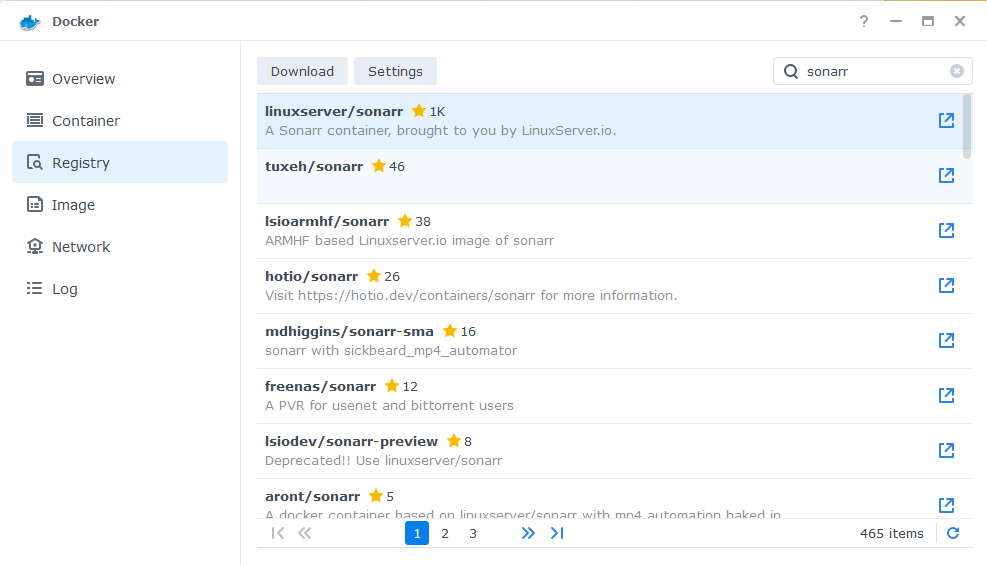
When the dialogue pops up asking you to choose a version, make sure you choose ‘Latest’ from the list.

You can check the status of the download over on the ‘Image’ tab.
Setting up the container
In Docker click on the ‘Image’ tab, in the list of your containers select the ‘Linuxserver Sonarr’ image and click on ‘Launch’
You will be greeted with the Network screen, we will be using the ‘synobridge’ network we created earlier select it from the list and click Next.
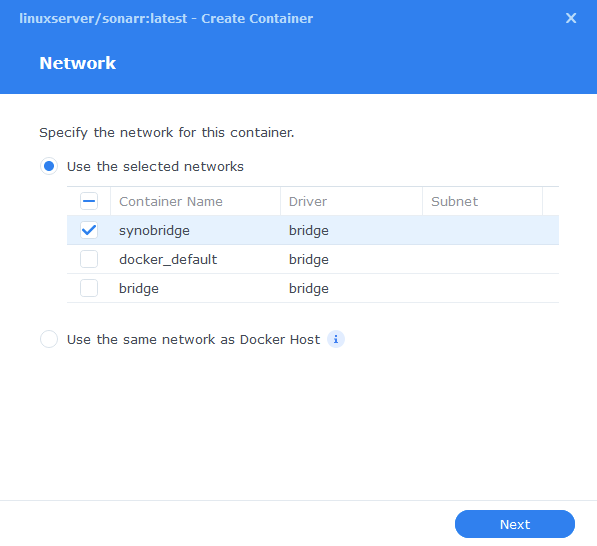
General Settings
Next you will be greeted with the General Settings screen, this is where you can start specifying some of your preferences.
You can change the name of the container to anything you like, and you may want to enable Auto Restart as this will ensure Sonarr starts automatically if you reboot your NAS.
You will also notice a Configure capabilities button — don’t change anything in here!

Next up we are going to click on the ‘Advanced Settings’ button, this will take you to a new window with a number of tabs which we are going to work through.
Environment (PGID, PUID and Timezone)
Next we are going to set up a couple of environment variables that docker will use to allow the container access to our files and folders and also to tell it where we live in the world.
Click the Add button, and fill in the following details as per the table/screenshot, you will need to do one at a time.
| Variable | Value |
|---|---|
| PUID | The UID you obtained in the user setup guide |
| PGID | The GID you obtained in the user setup guide |
| TZ | Your timezone wikipedia.org/wiki/List_of_tz_database_time_zones |

Links / Execution Command
You do not need to set up anything on these tabs.
Press ‘Save’ to go back to the initial setup screen, then press ‘Next’
Port Settings
We won’t be changing any of the ports the container uses. You can repeat the ones shown on the right side of the settings page ‘Container Port’ onto the left side ‘Local Port’ once you have done this press ‘Next’.
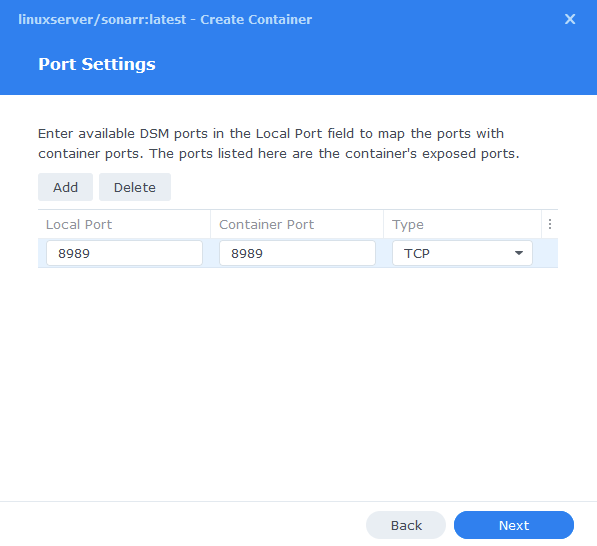
Volume Settings
We will now be specifying the directories where Sonarr will store its configuration files and where to find our media and downloads.
Click on ‘Add Folder’ select the ‘docker’ folder and create a new sub-folder called ‘sonarr’ select this folder and click ‘select’
Repeat this process to add the /data folder.

You will now add the below settings into the ‘Mount path’ section
| File/Folder | Mount path |
|---|---|
| docker/sonarr | /config |
| data | /data |

Click Next to move to the final screen.
Summary
You have now completed the setup of the container.
You will be shown an overall summary of the settings we have specified, this is a good time to double-check everything is correct. Finally, click on Done and the container should start to boot.
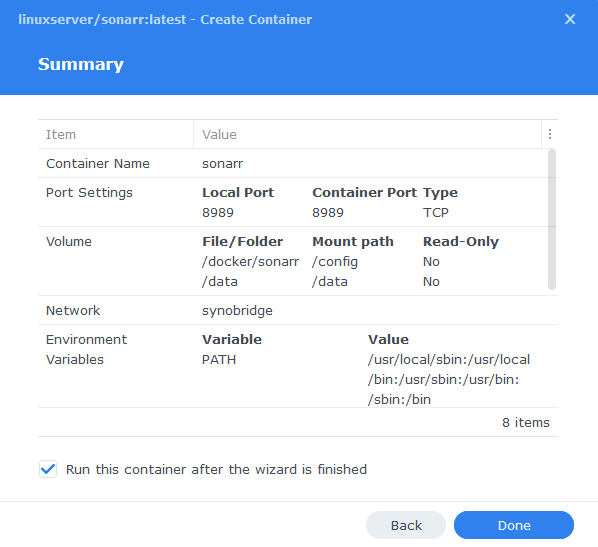
You should now be able to access Sonarr via the IP of your NAS followed by the port 8989
e.g. 192.168.0.40:8989
Key Settings and FAQ
Now you have set up Sonarr there are some key settings you will need to set as these often catch new users out. I will add more as they come up.
Media Management / Root Folders (Settings>Media Management)
Sonarr refers to the place(s) you keep your TV shows as Root Folders. These are where Sonarr will ultimately move your series episodes to once they finish downloading.
| App | Root Folder |
|---|---|
| Sonarr | /data/media/tv |
Download Clients (Settings > Download Clients>Remote Path Mappings)
While most of the settings on this page are self-explanatory something that has caught people out if the Remote Path Mappings setting. If you are hosting all your services on the same NAS do not add any settings here.
I can’t get Sonarr to Connect to my Download Client!
When setting up your preferred download client or Prowlarr etc. Usually you will use the IP of your NAS, however if for whatever reason this is not working you can use http://172.20.0.1 which is the IP of the ‘synobridge’ gateway.
| Update History | Date |
|---|---|
| Added Docker Compose details Added new folder mappings to ensure atomic moves and Hard-linking | 03/05/2021 |
| Guide re-written and updated with DSM7 screenshots | 01/08/2021 |
| Updated wording in some sections and updated the Docker Compose | 16/12/2021 |
| DSM7.1 Updated Screenshots and Steps | 03/06/2022 |
| Added new port settings and Docker Bridge Network | 24/07/2022 |
| Compose version number removed and small wording amendments | 08/04/2023 |
| Amended the path to save the compose file – this is for security, so the container has no access to the file contents. | 14/04/2023 |
Looking for some help, join our Discord community
If you are struggling with any steps in the guides or looking to branch out into other containers join our Discord community!
Buy me a beverage!
If you have found my site useful please consider pinging me a tip as it helps cover the cost of running things or just lets me stay hydrated. Plus 10% goes to the devs of the apps I do guides for every year.
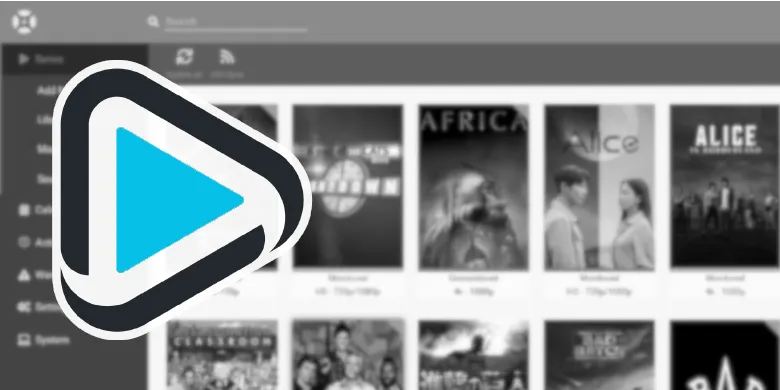



Hi – thank you for this great write up. It got me up and running with Sonarr in minutes.
I do have one question (apologies if I just missed this in the directions, or if I missed a setting in the Sonarr UI):
I’m on a Synology 920+, running Sonarr in Docker and Download Station natively, with Plex as my media server.
Using your instructions, I’m able to add shows to Sonarr and have them automatically download to my Downloads folder (default location for Download Station).
However, the show then just sits in the Downloads folder (/volume1/Downloads). How do I tell Sonarr to move it to my Plex library (/volume1/video/TV Shows)?
I’ve enabled “Rename Episodes” and “Use Hardlinks” in the Sonarr UI. Do I need to do something with “Remote Path Mappings”? Or is it a directory/permissions setting in Docker?
I’m guessing that somewhere in the workflow I need to tell Sonarr where to move the completed download, and I’m not sure how or where to do that.
Appreciate the help!
OR – am I approaching this backwards and instead of pointing Sonarr to my Plex TV folder (/volume1/video/TV Shows), I need to point my Plex TV folder to Sonarr (data/media/tv)? And copy all of my existing Plex TV files over to that data folder?
Hi Jim, you will find that hardlinks won’t work as you are going to need to have multiple paths mapped to your Sonarr container
When you did your path mappings did you mount the /downloads directory into Sonarr as well? If not Sonarr cannot access the files that have downloaded for it to move to your final /video folder.
If you have Discord might be worth reaching out so I can talk you through it.
Interestingly I’m finding that Sonarr won’t move downloaded media once completed. Does it irrespective of using Transmission or Deluge as the torrent client.
Got a brand new installation, and it’s still exhibiting the same behaviour…
Privileges are correct, folder ownership is correct, yet works fine using Sonarr v2
worked it out, despite mapping /video/tv as /tv on the Sonarr container, it was expecting it to be mapped as /video/tv to /TV…
now to retrofit on my production NAS….
Really cannot thank you enough for these great tutorials!
Everything working perfectly. Coffee coming!
Having an issue where Sonarr can’t see and import the file once downloaded. In the logs it suggests the file either isn’t there or it’s a permissions issue. The User has read/write permissions and the Data folder is mapped (and works as I have imported media from it) so I am unsure what is going on. I know it’s possible to adjust download permissions in SABnzbd, is that maybe the solution?
Think I resolved it! Looks like file paths are case sensitive and SAB “Usenet” folder was mapped to lowercase “usenet”, so that’s where Sonarr was looking, but Sonarr could only see “Usenet”
Hey, yeah in Linux folders are all case-sensitive, so I always try to stick with lower case.
Hi every one,
my radarr docker setup is running perfectly fine but i’m stuck with sonarr
when looking at the logs, the last line is :
[Info] LanguageProfileService: Setting up default language profiles
if anyone knows how to get out of this hole !
(syno 6.2.3 if this is important)